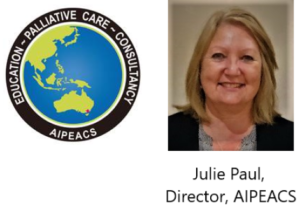
日本語訳監修: 木下佳代子 ジェックス参与
今月は、患者の視点が私たちの提供するケアをどのように導くべきかについて考えてみたいと思います。
私たちは患者を、たとえば35番ベッドの人、あるいは38番ベッドの心不全の人と呼ぶことが多いのではないでしょうか。 このような言い方をすると私たちは鈍感になり、患者中心のケアへのアプローチができません。 また、患者を疎外し、私たちは患者を気にかけていないという感覚を患者に抱かせ、不必要に不安や恐怖を増大させる結果になりがちです。
2023年の今になって、この話題はまだ議論すべきものではありません。 しかし看護の世界では、現実はそうなっています。 私たち誰もが、医療現場や家族の中で、看護師の共感や患者中心のケアを感じられなかった経験があるでしょうか。
もし私たちが、病気になる前の患者が、その人がどんな人なのかを尋ねなければ、どうやって患者中心のケアを提供すればいいのでしょうか?患者はどのようにコミュニケーションをとるのが好きなのか、又は、患者にとって何が大切なのか、これらはすべての患者に尋ねるべき基本的な質問です。
私たちは患者のストーリーをどれだけ知っているでしょうか? 患者のストーリーが私たちの提供するケアにとって極めて重要であることを理解して実践しているでしょうか?
オーストラリアのエンド・オブ・ライフ・エッセンシャルズ・プロジェクトは最近、「患者の視点」と題した新しいアニメーション・ビデオを発表しました。 このアニメーションは、医療従事者が実際の患者から学んだ重要な教訓に基づいており、患者を個人としてとらえ、病気を超えた人生を持ち、共感をもって対応するよう促しています。 私たちが毎日ケアを提供する場合に、患者の声を聞くことの必要性を再認識させてくれます。 ぜひお聴きいただき(英語ですが、ご自由に繰り返しご覧いただけます)、この重要な教訓を日々の臨床にどのように取り入れることができるか、あなたの考えや気持ちを話し合ってみてください。https://www.endoflifeessentials.com.au/tabid/7640/Default.aspx#PatientVideo
このビデオにあるメッセージの重要性を本当に理解できるのは、私たち自身、あるいは私たちの愛する人が患者になってからだと思います。 皆さんのご意見をお聞かせください。
ご興味のある分野に応じて、興味深いサイトやポッドキャストをいくつかご紹介します:
- ● - ポッドキャスト 知的障害や学習障害のある人と終末期について話す
https://every1dies.org/2023/s4e32-how-to-talk-about-end-of-life-with-
someone-that-has-an- intellectual-or-learning-disability/
- ● - 障害のある人のための健全な死に方: 終末期のコミュニケーションを支援する
- ために開発されたツールキット
- https://youtu.be/oU1u8PTkF3g
- ● – パネルディスカッション: LGBTIQ+ コミュニティに対する、患者中心の、
- 文化的に配慮した緩和ケアの提供
- https://palliativecare.org.au/event/pca-connect-embracing-inclusion-providing-
- supportive-palliative-care-for-lgbtiq-communities/
- ● - 終末期におけるスピリチュアルケアの分かり易い解説:
- https://www.youtube.com/watch?v=GaZ1wn11M-0&t=21s
もし、さらに話し合いたい分野があれば、メール(julie@palliativeeducation.com)で
お知らせください。
来月のキャッチアップを楽しみにしています。
お元気で。 Julie
事務局より:
ジュリーさんは、皆様からの感想、質問などをお待ちしています。
-
Disclaimer: November 2023 免責条項:
Australian International Palliative Education and Consultancy Services (AIPEACS) は、Julie’s Update シリーズ内 -
の内容につき正確な情報の提供に細心の注意を注いでいますが、特にある事柄についての専門的意見を提供するもの
-
ではありません。このシリーズに含まれる情報は、独立した専門家の見解に取って代るものではありません。
-
また、医療上の助言として利用したり、何らかの疾患の治療、手当、又は、予防のために使用されるものではありません。
AIPEACSは、このシリーズにより提供される情報の利用、依存によるいかなる法的責任、怪我、紛失、損害については、 -
責任は負いません 。
Australian International Palliative Education and Consultancy Services Pty. Ltd -
Julie’s Update: November 2023 (原文) -
This month I would like us to think about how the patient’s perspective should lead the care we provide.
-
I am wondering how often do we refer to patients as the person in bed 35 for example or the man with heart failure in bed 38. This type of language desensitizes us and does not enable a patient centred approach to care. It also alienates the patient and contributes to the patient having a sense that we don’t care, and often results in unnecessary increased anxiety and fear.
In 2023 this is not a topic we should still be discussing. In nursing however, the reality is that we do. We have all probably experienced a time in health care or with a family member where the nurse’s empathy and patient centred care was not evident.
How do we provide patient centred care if we are not asking our patients about who they are as a person before their illness? How do they like to be communicated with? What is important to them are the basic questions we should be asking every patient.
How much of the patient’s story do we know? Do we practise with an understanding that the patients story is pivotal to the care we provide?
The End of Life Essentials Project in Australia recently released a new animated video titled – A Patients Perspective. The animation is based on the important lessons to health professionals from an actual client which encourages us to view patients as individuals, with lives beyond their illness and respond to them with empathy. It is a great reminder of the need for us to hear the patients voice in every day that we provide care. I would encourage you to have a listen (it is in english but you can watch the clip repeatedly at your leisure) and discuss your thoughts and feelings about how you can embed the important lessons in your everyday clinical practice. https://www.endoflifeessentials.com.au/tabid/7640/Default.aspx#PatientVideo
I think until we are a patient ourself, or our loved ones are, that we can truly understand the importance of the messages in this video. I am very interested in your thoughts, please let me know what you think.
Here are a couple of sites/podcasts that you may find interesting depending on your areas of interest:
- ● Podcast: Talking about end of life with someone that has an intellectual or learningdisability
- https://every1dies.org/2023/s4e32-how-to-talk-about-end-of-life-with-someone-that-has-
- an-intellectual-or-learning-disability/
● Healthy Dying for People with Disability: A toolkit developed to assist with communicating for end of life
- ● Panel discussion: Providing supportive patient centred and culturally sensitive palliative care
- for the LGBTIQ+ communities https://palliativecare.org.au/event/pca-
- connect-embracing-inclusion-providing-supportive-palliative-care-for-lgbtiq-communities/
- ● Unpacking spiritual care at the end of life- https://www.youtube.com/watch?
- v=GaZ1wn11M-0&t=21s
If there are any particular areas you are interested in discussing further please let me know via email julie@palliativeeducation.com
I am looking forward to our next month’s catch up.
Take care Julie
